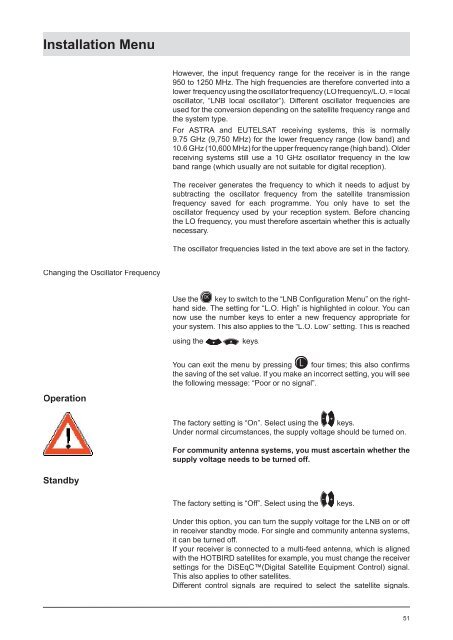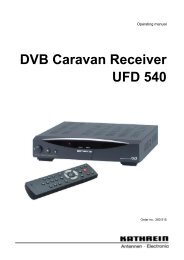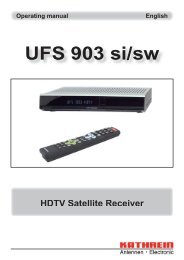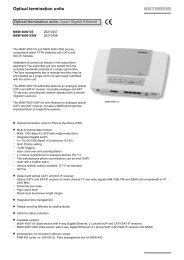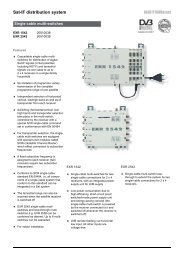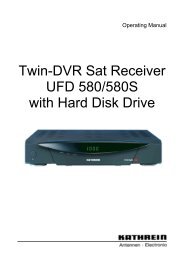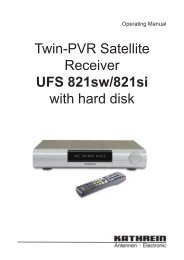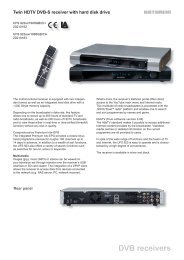9362705b, Operating Manual UFD 170 DVB-S Receiver ... - Kathrein
9362705b, Operating Manual UFD 170 DVB-S Receiver ... - Kathrein
9362705b, Operating Manual UFD 170 DVB-S Receiver ... - Kathrein
Create successful ePaper yourself
Turn your PDF publications into a flip-book with our unique Google optimized e-Paper software.
Installation Menu<br />
Changing the Oscillator Frequency<br />
Operation<br />
Standby<br />
However, the input frequency range for the receiver is in the range<br />
950 to 1250 MHz. The high frequencies are therefore converted into a<br />
lower frequency using the oscillator frequency (LO frequency/L.O. = local<br />
oscillator, “LNB local oscillator”). Different oscillator frequencies are<br />
used for the conversion depending on the satellite frequency range and<br />
the system type.<br />
For ASTRA and EUTELSAT receiving systems, this is normally<br />
9.75 GHz (9,750 MHz) for the lower frequency range (low band) and<br />
10.6 GHz (10,600 MHz) for the upper frequency range (high band). Older<br />
receiving systems still use a 10 GHz oscillator frequency in the low<br />
band range (which usually are not suitable for digital reception).<br />
The receiver generates the frequency to which it needs to adjust by<br />
subtracting the oscillator frequency from the satellite transmission<br />
frequency saved for each programme. You only have to set the<br />
oscillator frequency used by your reception system. Before chancing<br />
the LO frequency, you must therefore ascertain whether this is actually<br />
necessary.<br />
The oscillator frequencies listed in the text above are set in the factory.<br />
Use the key to switch to the “LNB Confi guration Menu” on the righthand<br />
side. The setting for “L.O. High” is highlighted in colour. You can<br />
now use the number keys to enter a new frequency appropriate for<br />
your system. This also applies to the “L.O. Low” setting. This is reached<br />
using the keys.<br />
You can exit the menu by pressing four times; this also confi rms<br />
the saving of the set value. If you make an incorrect setting, you will see<br />
the following message: “Poor or no signal”.<br />
The factory setting is “On”. Select using the keys.<br />
Under normal circumstances, the supply voltage should be turned on.<br />
For community antenna systems, you must ascertain whether the<br />
supply voltage needs to be turned off.<br />
The factory setting is “Off”. Select using the keys.<br />
Under this option, you can turn the supply voltage for the LNB on or off<br />
in receiver standby mode. For single and community antenna systems,<br />
it can be turned off.<br />
If your receiver is connected to a multi-feed antenna, which is aligned<br />
with the HOTBIRD satellites for example, you must change the receiver<br />
settings for the DiSEqC(Digital Satellite Equipment Control) signal.<br />
This also applies to other satellites.<br />
Different control signals are required to select the satellite signals.<br />
51


